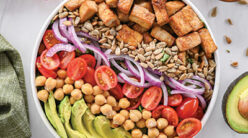Even small savings on a weekly, biweekly, or monthly grocery shopping trip can add up over time, so it pays to try different money-saving strategies.
• Buy in bulk.
Often, herbs and spices, grains, dried beans and lentils, nuts, and dried fruits are cheaper when shopping in the bulk section of a brick-and-mortar or online grocery store. Some websites specialize in offering bulk pantry staples, so it’s worth seeing if using them for certain foods will save you some money.
• Eat more meatless meals.
Plant-based protein sources, such as beans, lentils, tofu, and tempeh, are usually more affordable per serving than meat, seafood, and poultry. According to a study by Oxford University, vegetarian and vegan dietary patterns that replaced animal products with legumes and whole grains were more affordable than even flexitarian or pescatarian diets.
• Choose store brands.
The off-brand or generic versions of staple foods offered by grocery stores are usually more affordable and offer comparable nutrition compared to name brands. Try store-brand versions of whole-wheat bread, oats, breakfast cereal, applesauce, canned beans and vegetables, and more—you probably won’t notice much of a difference, if any, in taste.
• Make a list.
It’s easy to get distracted by exciting new products, but sticking to a shopping list can help you avoid impulse purchases. It can also prevent unused food from going to waste. It’s okay to add last-minute things you usually buy but forgot to put on your list, like bread or bananas, but try to avoid purchasing things that you don’t have a specific plan for.
• Check for discounts.
It’s worth checking to see whether your grocery store offers any coupons or deals. Many stores publish a weekly advertisement that announces their sales, which can be useful when planning meals for the next week.
• Try canned and frozen produce.
Canned and frozen vegetables can often be used in place of fresh for certain dishes like soups and stews. Similarly, frozen berries are usually much more affordable than fresh, are great in smoothies, and provide the same amount of anti-inflammatory antioxidants.
• Shop seasonal produce.
It’s often more affordable to buy tomatoes in the summer and brussels sprouts in the fall since these are the times of year when they’re in season. During these times, growing conditions are more effective and yields are usually higher.
• Plan meals around the most affordable produce.
In general, certain fruits and vegetables tend to consistently be the most affordable. Onions, carrots, and celery can be used as a classic base for soups, and tomatoes can be used in a simple sauce for pasta. Similarly, apples, oranges, and bananas usually provide more fruit for your money than fresh berries or pomegranates.
• Limit pre-prepped fruits and vegetables.
The convenience of buying pre-peeled and pre-chopped fresh produce is amazing, but it’s almost always more expensive than preparing it yourself. A good rule of thumb is that the less preparation you have to do, the more it will cost. Of course, not everyone has the time to make everything from scratch, so you’ll need to find a balance between budgetary and time constraints that works for you.
• Organic isn’t a must.
Organic produce is great if it fits your budget, but it isn’t the only nutritious option. Research has shown that organic produce isn’t significantly more nutritious than conventional produce, which is just as safe. If you’re worried about pesticides, washing produce thoroughly under cool running water can help remove pesticide residues.
• Try “subscribe and save” options online.
Many online retailers offer modest savings when you set up auto-deliveries for staple items that are a regular part of your grocery orders.
Stephanie Wells, MS, RD, LD, ACSM-CPT, is a registered dietitian specializing in plant-based nutrition. She has prior experience in cancer research and has been published in numerous scientific journals.






